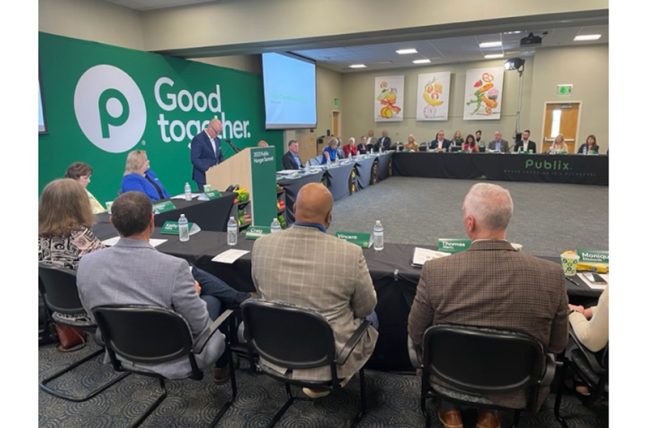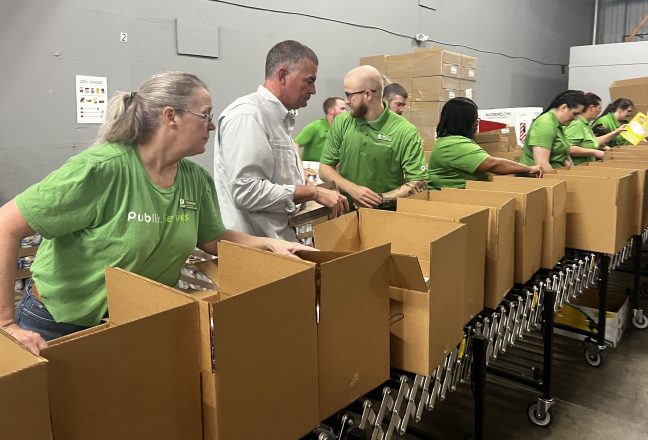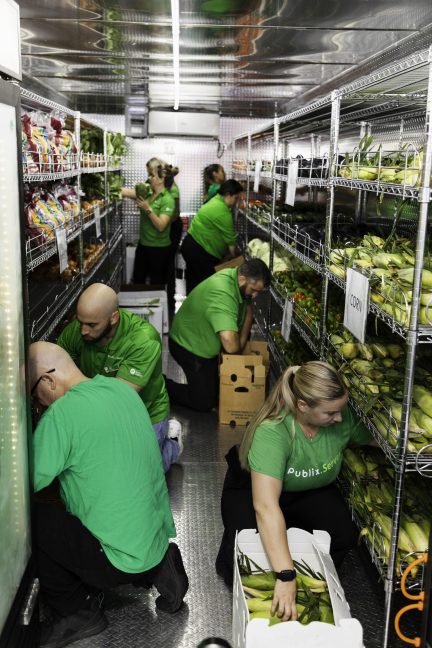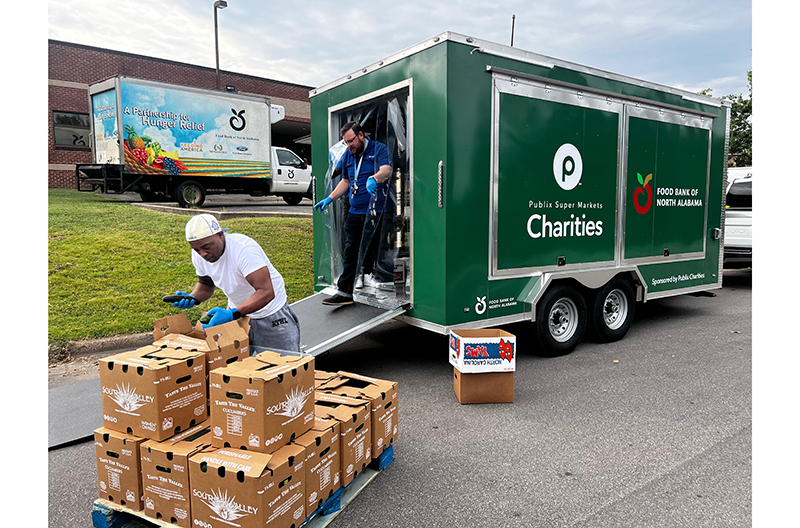Publix long has been working to alleviate hunger in the communities it serves. That effort reached a new level in early 2023, when the company hosted a Hunger Summit at its Lakeland, Florida headquarters.
Executives from 35 Feeding America member food banks in the Publix operating area attended, along with state and federal officials. Company leaders shared best practices in talent acquisition, sourcing, warehousing and distribution.
Executive Chairman Todd Jones told Shelby Publishing that trying to alleviate hunger is a strong pillar for the company.
“As a food retailer, it’s our space. That’s where we should be … We know food, and we know how we can help communities with people in need. I think our first Hunger Summit was a good effort.”
Jones said the summit did a good job of bringing people together and recognizing that not all food banks have the same needs.

“All of our Feeding America partner food banks that are out there, they are all uniquely different depending on the area. We were sending food to Miami that might have needed to be different than what is in Orlando or maybe South Carolina,” he said.
Some of the feedback from the food banks was a desire to pick from “a different recipe of foods.”
“We really worked on trying to make sure we can do that,” Jones said. “It sounds simple, but it’s not as simple as it seems. That’s something that was a really big takeaway for us, to see how we can actually make it more relevant to the different communities that we operate in.”
Jones added that he thought the summit was a “home run” and will only get better in the future. Publix is planning for another Hunger Summit in 2025. In the meantime, the company is considering the feedback it has received from its partners.
Jones said they are looking at expanding the next summit, possibly bringing in more people with the ability to “help us break down some barriers and walls.”
View the photo gallery from the inaugural Hunger Summit held by Publix.
Addressing need for protein
One of the biggest requests from food banks is for more protein, which is harder to provide than shelf-stable products. Publix is working on a way to donate proteins that are still wholesome. Part of that is the development of a passive pickup program for chicken.
“We have a great chicken program, but it has a short window in our stores,” Jones said. “When we pull that product back, it’s still good. So we can chill blast that product, get it down underneath the hot temperature so that bacteria goes way down really quick.”
After that process, it’s just a matter of getting the chicken to the Feeding America food banks.
Maria Brous, director of communications at Publix, said this has been an important project that Jones has challenged staff to “figure out.”
“Todd has very much been a proponent of how do we help feed more people in need. We are continuously challenged to figure out ways to keep food out of landfills and feeding people,” she said.
The company has been working with its Quality Assurance associates and with the University of Florida on the project. They have conducted tests on the blast chill process.

“We’ve frozen the product, thawed the product and reheated it to ensure we’re donating good quality products to our neighbors in need,” Brous said.
She said one thing learned from the COVID-19 pandemic was that there are many families just one paycheck away from having to be in a food line.
Jones said the program is ready to go. While the leftover chicken at one store may not seem like a lot, maybe two packages that have to be pulled back, it adds up when more than 1,360 stores are considered.
“That’s three times a day times more than 1,360 stores. You could have just taken care of 1,700 families. It sounds small in its own little microcosm, but when you lift it up and look at it across the network, you can solve that for some of the customers out there in need,” Jones said.
Adding on to the protein part are the shelf-stable items and the “wonderful produce program that we have … it’s a win-win-win all the way across for our customers and our community. And our associates are all the way behind it. It fits right along with our brand,” he said.
Brous said the passive pickup program, which works with Feeding America food banks, allows partner agencies to come to Publix stores and use refrigerated blankets and coolers to transport food that’s been chilled and maintain that cold chain. That food goes back into the communities within 24 hours.
“When you talk about immediate help, immediate assistance, immediate need, it’s the most efficient way to do that, when you can get from here to the client in less than 24 hours through that passive pickup. That’s where we’re really trying to move the needle,” she said.
Mobile food pantries
Publix Super Markets Charities also is starting to provide mobile food pantries to Feeding America partner food banks to serve more clients and people living in food deserts.
“You might not be able to put a store out there, but you can send a trailer load of food and let the community know when we’re going to be there,” Jones said. “Open that up, let them come in and get that food and then take that trailer to a Feeding America food bank.
“We’ll take it back and we’ll fill it back up and send it out to the next place. There’s multiple ways to do the logistics side of it.”
Brous added that some of the mobile pantries made their debut during September, which was Hunger Action Month. She said mobile units can cover more ground and bring food to where people can access it without having to worry about transportation issues.
“There’s also the dignity component that we go back to, having families be able to pick their produce, be able to walk inside this pantry and pick what they need,” she said. “It’s valuing our neighbors. It’s giving them a hand up, not a hand down. It’s helping them understand that we’re part of their community. That’s one of the things we are most thankful for. Todd’s always had a vision for helping our communities and, food being our business, you have to be able to do that.”
Finding solutions to hunger is ultimate goal
During the pandemic, many businesses shut down temporarily or closed permanently. People lost their jobs. Today, with inflation and natural disasters such as hurricanes, flooding and tornadoes affecting the nation, Publix President Kevin Murphy said many people are faced with choices of how they are going to spend the little money that they have – rent, utility bills or putting gas in their car.
“We are seeing more people, for the first time ever in their life, have to reach out and ask for help. I think that’s what really motivates us to want to be able to do more and be able to contribute more…we see it everywhere,” Murphy said at the Hunger Summit.
Publix just concluded its Feeding More Together program, which ran Nov. 8-19, collecting more than $7.1 million. Murphy said in the past 12 years, the company has raised $177 million through the register program, which is donated to Feeding America affiliates and other nonprofit organizations.
He added that, in addition to the funds raised, Publix donated $10 million in produce for the year.
The produce donated is surplus, allowing farmers to earn money on what otherwise may just “sit in the ground and go to waste. It’s positive all the way around,” Murphy said.
Paco Veléz, president and CEO of Feeding South Florida, attended the Hunger Summit, which he deemed a “huge step for Publix … and a great win for our community. We’re excited and thrilled. Publix has always been our biggest donor of food and funds, and this just compounds that.”
During the summit, representatives from Publix Super Markets Charities announced a special $4 million grant opportunity available to select food banks in Publix’s operating area to fund non-recurring, capacity-building projects.
The opportunity is in addition to PSMC’s annual hunger alleviation donations announced in September 2022 during Hunger Action Month. It will bring the organization’s total contributions to help alleviate hunger to more than $52 million since 2015.

Veléz said the grant is a “huge, huge win for food banks but more importantly for families. It’s going to allow food banks to really think bigger.”
He said emphasis needs to be on finding solutions to the issue of food insecurity. “What are the steps we need to take? What are the systems we need to change in order to do this? I think forcing folks to think will only benefit the families that we serve.”
Veléz agreed with Murphy that, through a variety of circumstances, more families are having to reach out for help with food.
“The pandemic was really the beginning of a new issue for families … now we’re in full-blown inflation and families are struggling to make ends meet,” he said, adding that they are seeing families coming in every week.
“It went from being emergency food assistance to an ongoing sustainability. Especially in South Florida, the farther south you go the more expensive things become.”
In addition to providing food to families, Veléz noted that Feeding South Florida is trying to help them become more marketable in the workforce and get higher paying jobs. The organization has a warehouse training program, and Veléz said Publix has agreed to interview every one of its graduates.
“Publix is a great employer and has great benefits and salaries … once the (graduates) get their foot in the door, it’s a great opportunity to move their families toward self-sufficiency.”
Veléz said it is important to keep the issue of hunger in front of people. “Hunger is not a sexy topic. It’s people needing food.”
Keeping that awareness top of mind can make a huge difference.
“It just adds more folks to the table. And for food banks and folks that are serving people, there’s room at the table for everyone to get involved,” he said. “No matter where you’re from, what you do, there’s room at the table if you want to help.”
Publix hunger-relief efforts
The company’s hunger-relief efforts include:
- In-store perishable food recovery program. Every day in stores, associates gather wholesome but unsalable dairy, deli, meat and produce items to donate to food banks throughout the company’s seven-state operating area. Since 2009, it has donated more than 800 million pounds of food to Feeding America partner food banks.
- Feeding More Together. In March 2021, Publix launched its bi-annual Feeding More Together register campaign. Donations at the register provide nonperishable food needed most by local food banks and pantries. In addition, Publix purchases $5 million in fresh produce and donates it to Feeding America partner food banks. Since the campaign’s launch, the company, its associates and customers have provided more than 90 million pounds of food.
- Publix Serves. The company schedules two Publix Serves weeks every year where associates volunteer together in their communities to carry on founder George W. Jenkins’ (Mr. George) legacy of supporting neighbors. Since 2015, Publix Serves has united associates in community service efforts. During the Publix Serves week in September, more than 7,500 associates volunteered at over 200 nonprofits focused on hunger alleviation. Throughout the week, associates spent time together preparing meals, sorting produce, boxing food and doing good.
Read more independent store news from The Shelby Report.

